Sweet and fluffy Steamed Custard Buns, a yum cha favourite! Recipe with step-by-step photos.
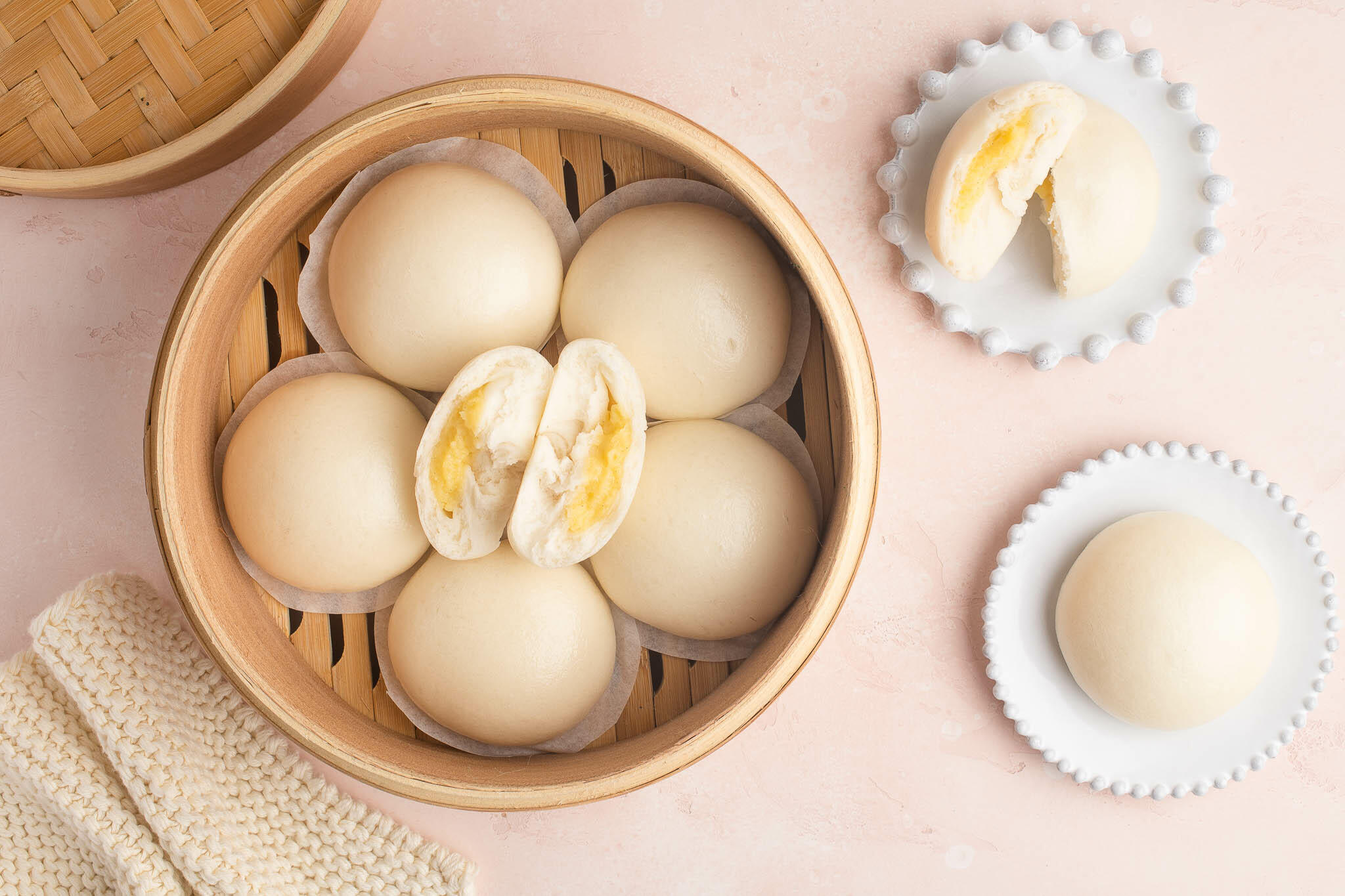
Yum Cha
When I was young, I used to envy my friends who would sit down to a proper roast lunch every Sunday. I imagined their family gatherings to be like in the TV commercials – happy faces all around the dining table, someone proudly bringing a platter of roast meat to the table, everyone tucking into their Sunday roast in a civilised dining room.
In my family, Sundays were instead often spent at a loud and noisy restaurant in Chinatown, where impatient diners would heckle the waitresses to get their attention, where families would loudly but joyously share from a bounty of bamboo baskets laden with steamed dumplings, and any roast in sight would be Peking duck or crispy pork belly.
In Australia, we call it Yum Cha, but in other parts of the world, this hectic Chinese “brunch” is known as Dim Sum. I miss these yum cha meals dearly and wish my younger self could have appreciated them more.

Steamed Custard Buns
Even if our bellies were full from feasting on too many dumplings, there was always room for dessert. My mother and I loved ending the meal with a shared tofu pudding served with ginger syrup. And if the Egg Custard Tarts were still warm from the oven, we would somehow find room for that too.
Once, we mistakenly ordered a plate of Steamed Custard Buns. I bit into one of these buns, thinking it was a Char Siu Bao, only to be pleasantly surprised that it was instead filled with a sweet, thickened custard. My mother thought they were too filling to be eaten as a dessert, especially if you had ordered Char Siu Bao as part of your yum cha banquet, but I found these sweet, pillowy buns to be a wonderful comfort food and frequently looked out for them.
Oddly enough, I felt that these Steamed Custard Buns disappeared from the menus of many yum cha restaurants, as other more popular dessert options started to emerge. I was only recently reunited with these sweet buns when my local Asian grocer stocked them in the freezer.
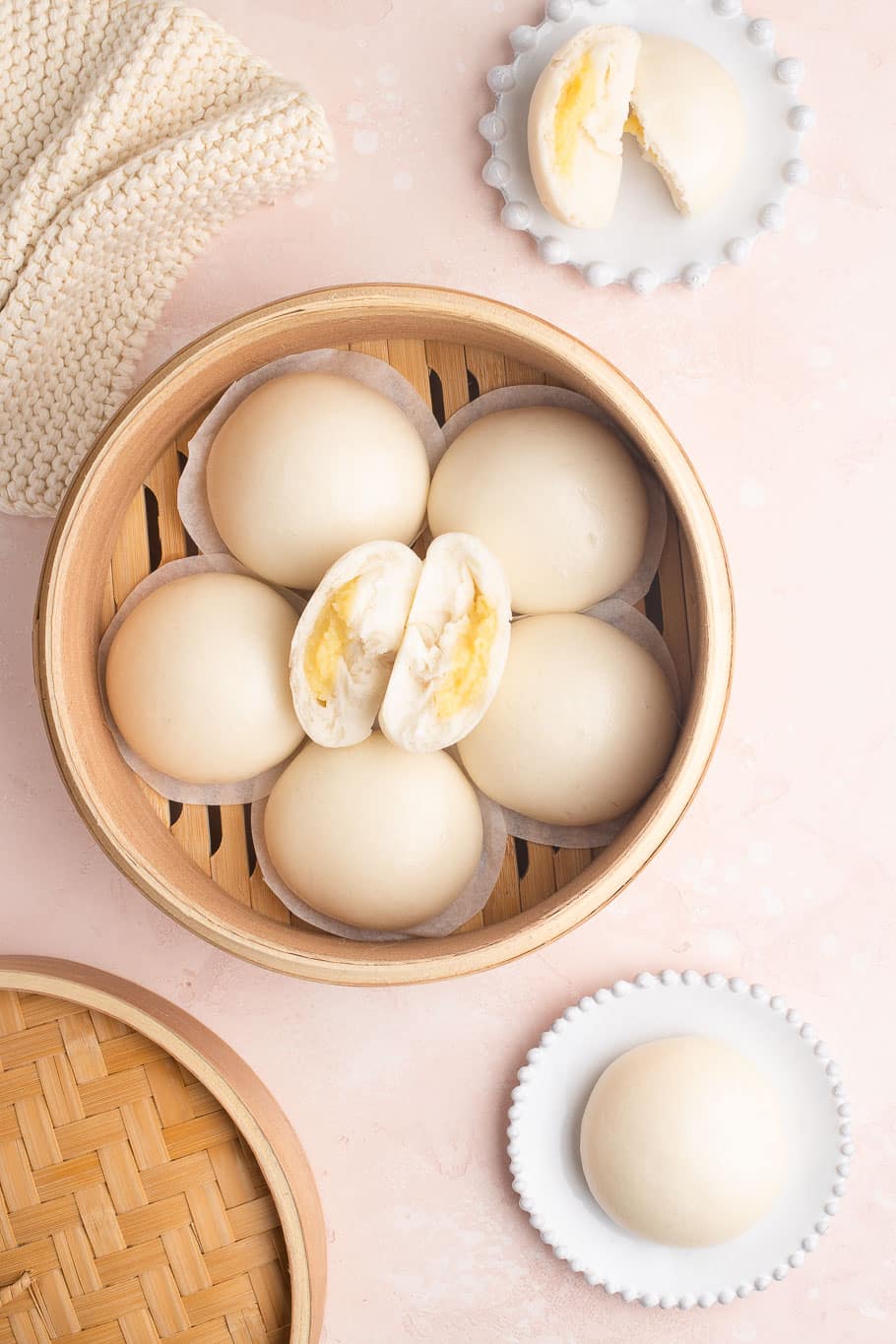
Steamed Custard Buns Recipe
One of the most popular recipes on my website is my Steamed Bao Buns. It’s an easy and foolproof recipe for soft and fluffy bao buns, and transforming them into Steamed Custard Buns requires just a few easy additional steps.
The custard filling is similar to a French Crème Pâtissiere (also called pastry cream), but I have adapted the recipe slightly to make it a firmer texture for the Steamed Custard Buns. I personally like to have a soft custard filling which will complement the fluffy steamed buns, but I don’t like the filling to be wet and runny. Also, I prefer to have a higher ratio of bun to filling, but you can adjust this to your preference.
Shaping the buns doesn’t require too much skill as, no matter how you pleat the edges together, the buns will nevertheless be steamed with the seam-side facing down.
How to Make Steamed Custard Buns
Step 1
Start by making the custard filling as it will need time to cool and firm.
To ensure that the custard has a silky smooth texture, I like to push it through a fine sieve to remove any lumps and over-cooked pieces of egg.
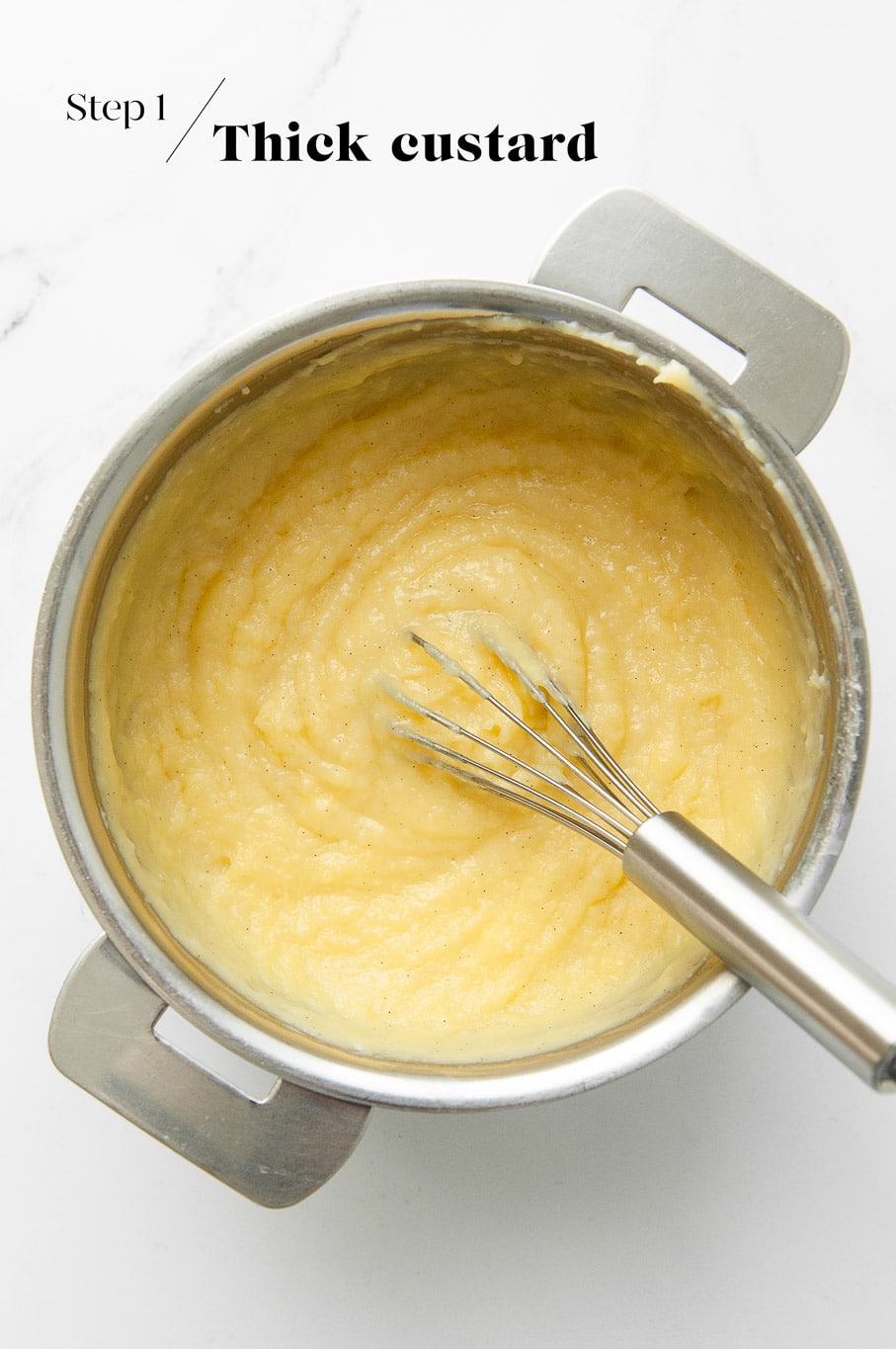
Step 2
My recipe for Steamed Custard Buns uses my recipe for Steamed Bao Buns to make the fluffy bun component.
You can find my recipe for Steamed Bao Buns with step-by-step photos here.
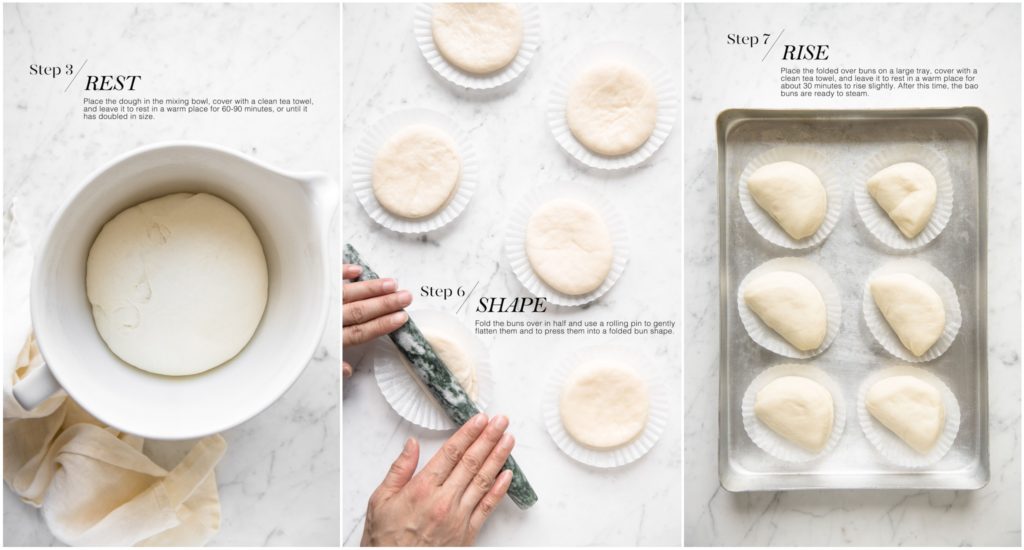
Step 3
Once the dough has doubled in size, gently remove the dough to a clean surface. Shape the dough into a large round ball.
Step 4
Use a large knife to divide the dough into 12 portions. Stretch and roll each piece of dough into a small ball.
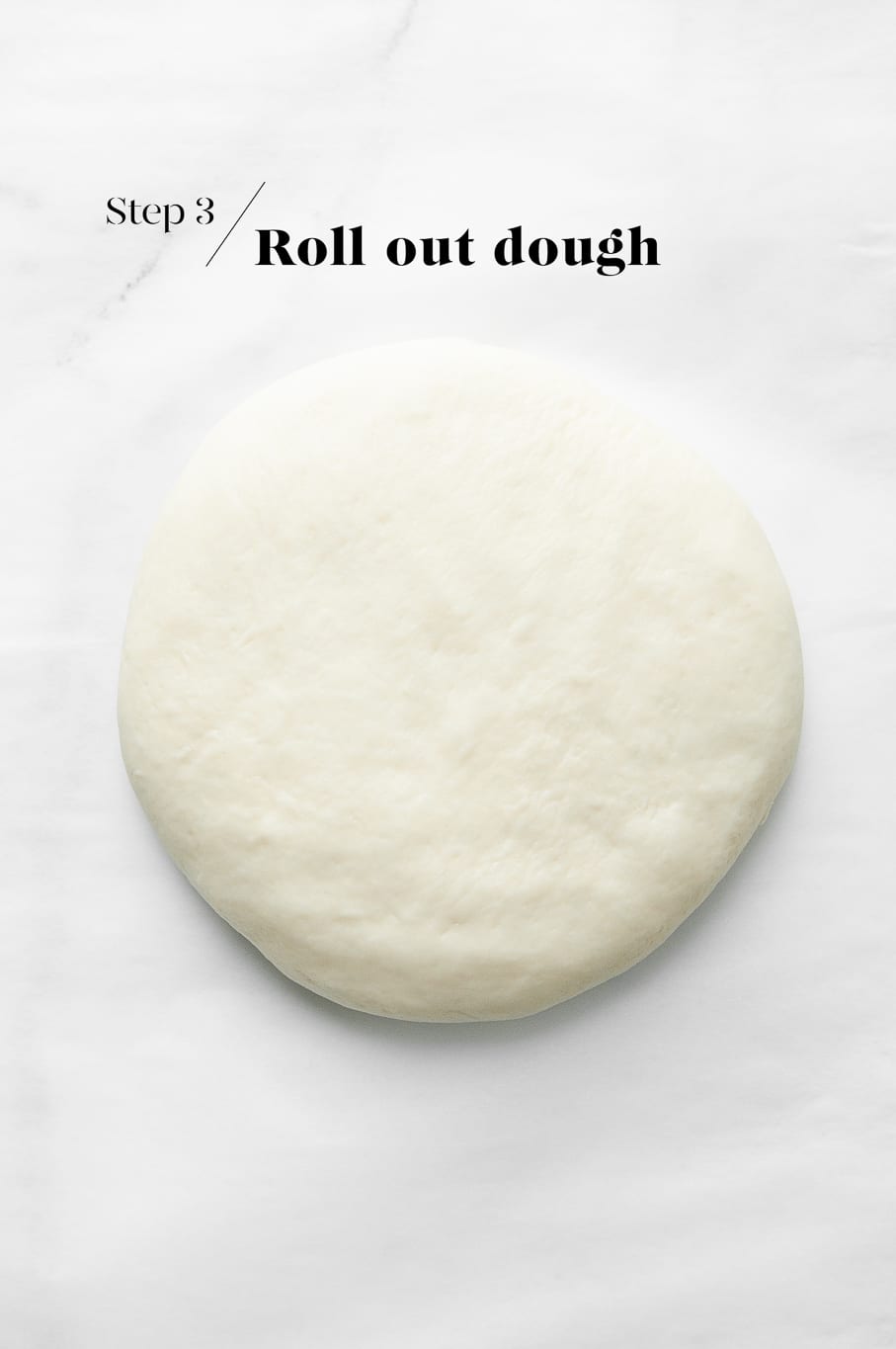
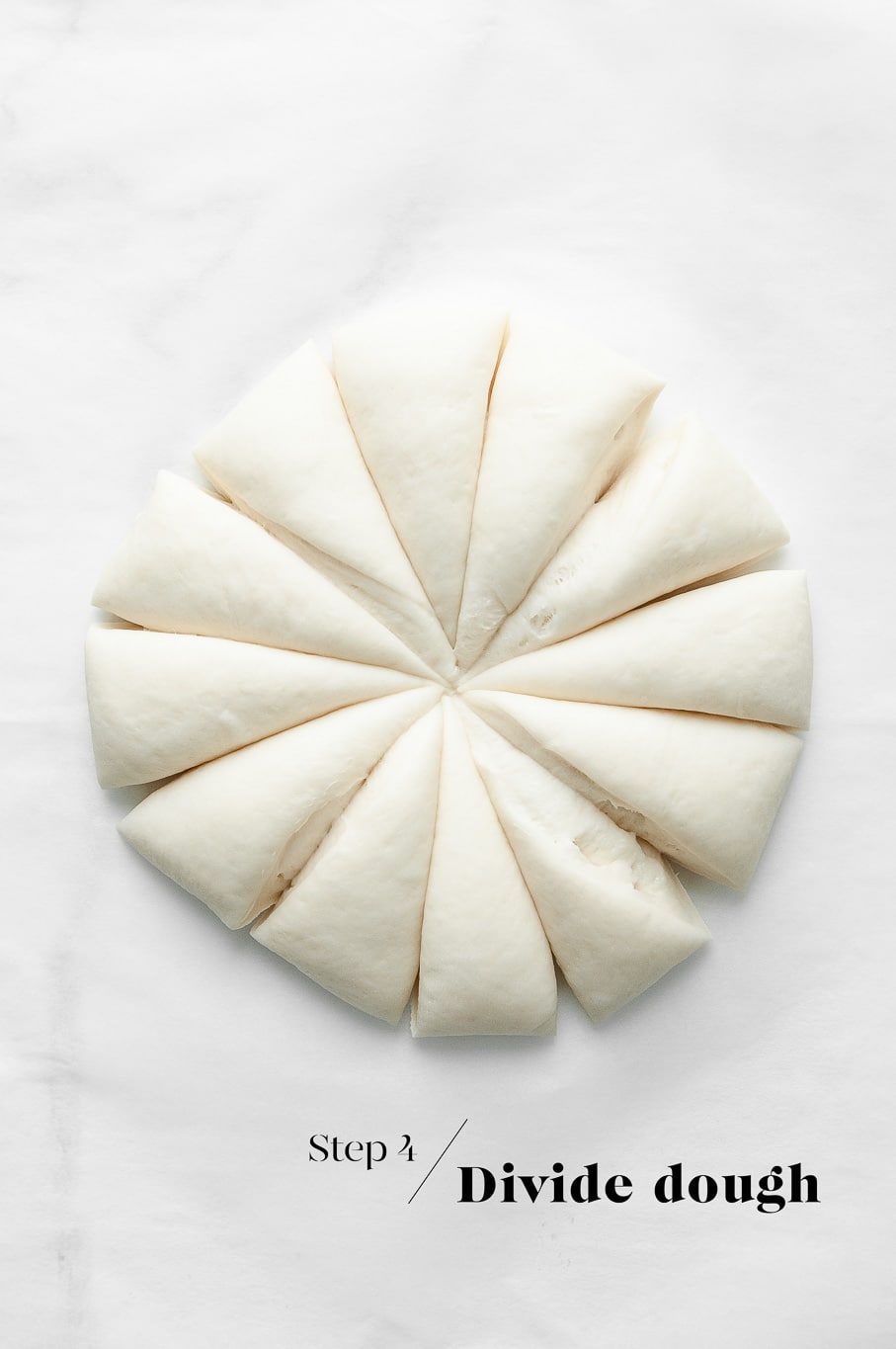
Step 5
Use a small rolling pin to roll out each piece of dough until it is about 10 cm/4 inches in diameter. Place a heaped tablespoon of custard filling into the centre of the dough (I use an ice-cream scoop for this task).
Step 6
Pinch together the edges of the dough, then twist and seal the buns together. Place the buns on a small sheet of baking paper with the seal facing down. Repeat with the remaining pieces of dough.
Cover the tray of buns with a clean, damp tea towel, and place them somewhere warm for about 30-45 minutes, or until they have puffed up slightly.
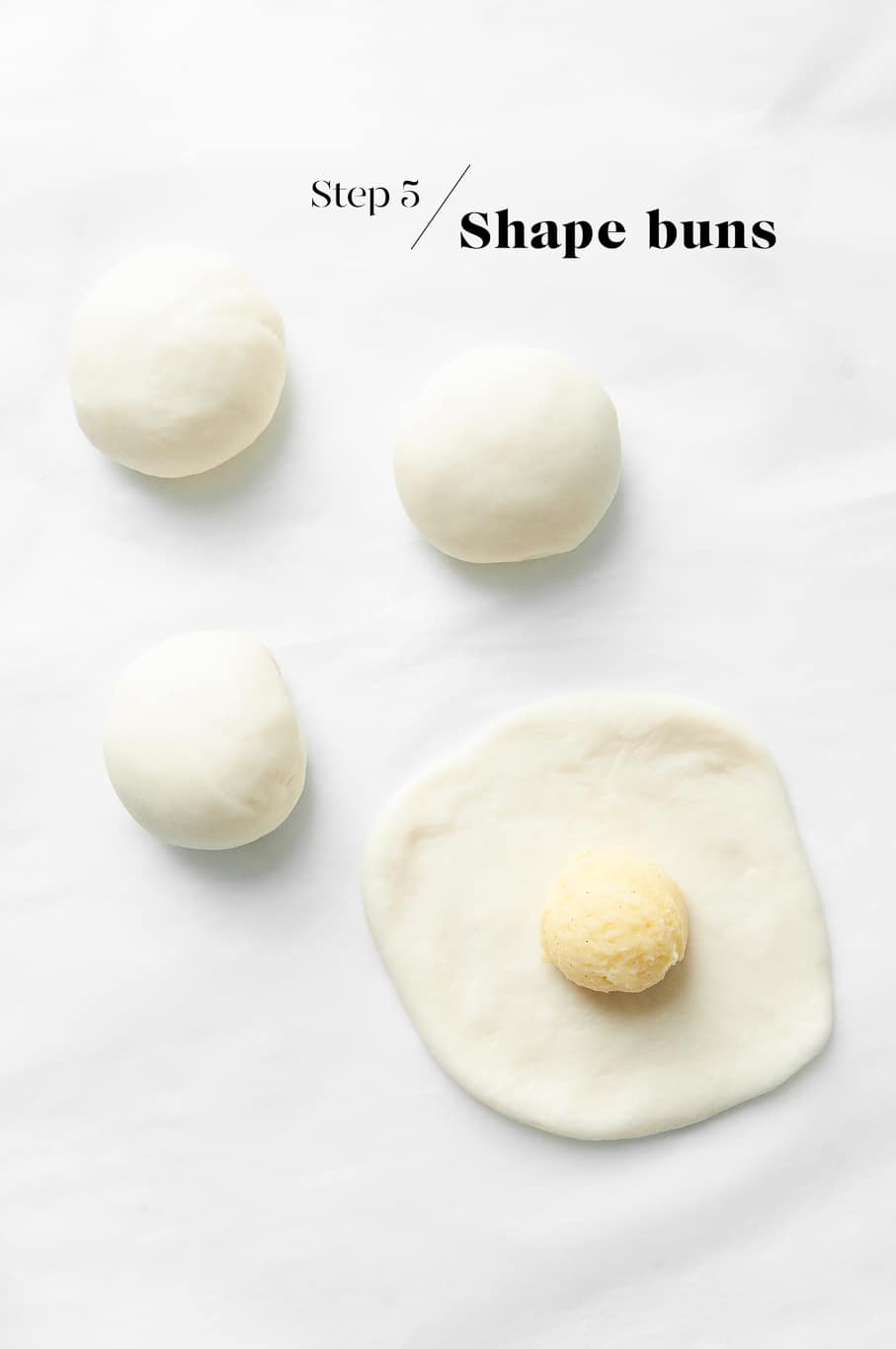
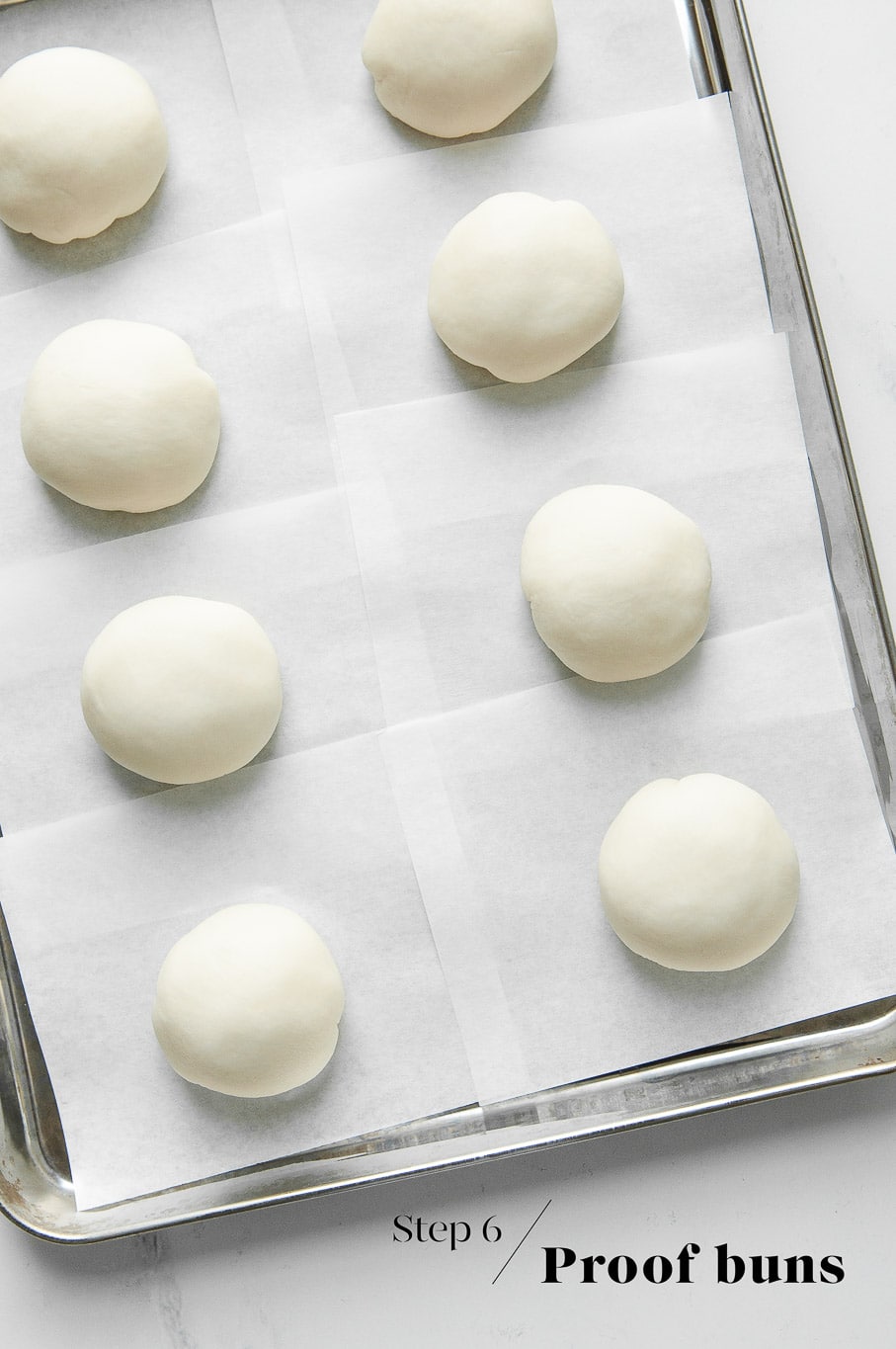
Step 7
Steam the buns for 10 minutes. You can steam the buns in a bamboo steamer, stainless steel steamer, or in a steam oven. Please see the recipe card below for more instructions.
Tips for Making Steamed Custard Buns
- Start by making the custard so that it has time to set and firm up in the fridge. You can make the custard up to a day in advance.
- Use an ice-cream scoop to portion the custard. I use one with a 1 tablespoon capacity.
Freezing Steamed Custard Buns
Like regular Steamed Bao Buns, any leftover cooked buns can be frozen in ziplock freezer bags or vacuum-sealed bags.
To reheat the buns, simply steam the frozen buns for about 10 minutes, or microwave the buns on high for a few minutes, until the buns are warmed through.
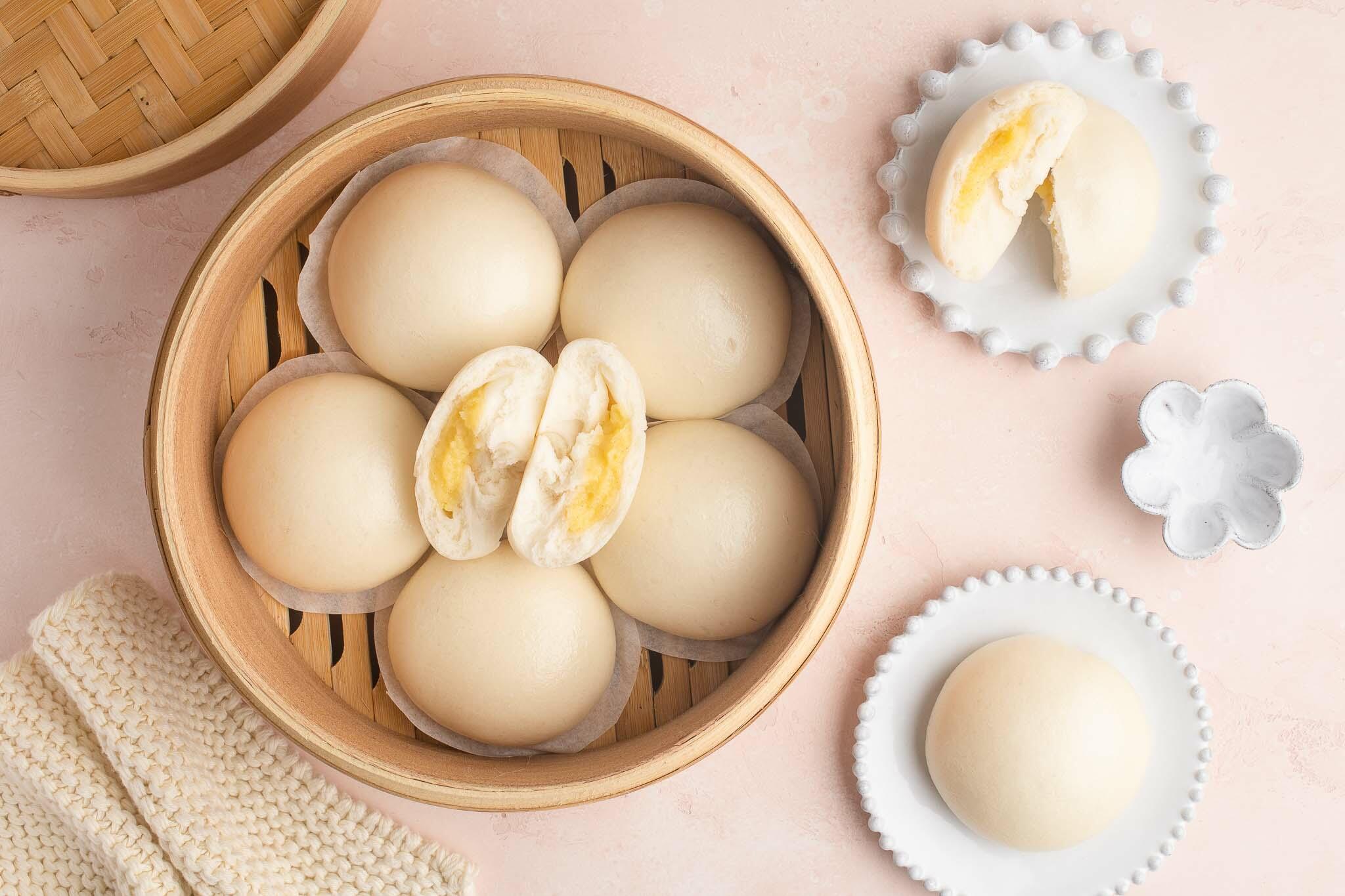
Steamed Custard Buns
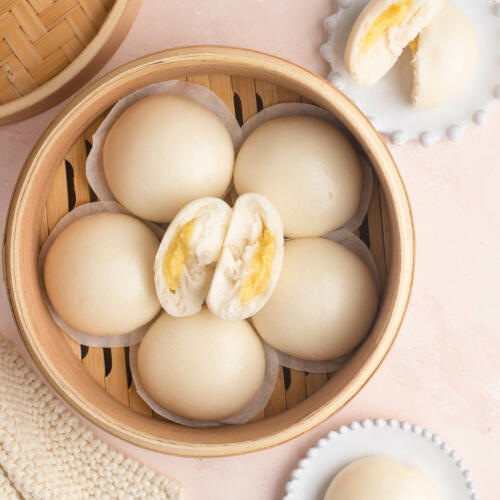
- Resting Time: 2 hours
- Author: Thanh | Eat, Little Bird
- Prep Time: 1 hour
- Cook Time: 10 mins
- Total Time: 1 hour 10 minutes
- Yield: Makes 12 buns
- Category: Dessert
- Method: Steamer
- Cuisine: Chinese
Sweet and fluffy Steamed Custard Buns, a yum cha favourite! Recipe with step-by-step photos.
Ingredients
For the Custard Filling
- 2 eggs
- 75 g (1/3 cup) caster sugar or vanilla sugar
- pinch of fine salt
- 2 tablespoons cornflour (US: cornstarch)
- 160 ml (2/3 cup) double cream (heavy cream)
- 1 teaspoon vanilla extract or vanilla bean paste (omit if using vanilla sugar)
For the Steamed Bao Buns
- 300 g (2 cups) plain flour (all-purpose flour) or bleached flour
- 125 g (1 cup) cornflour (US: cornstarch)
- 5 tablespoons caster sugar (super-fine sugar)
- 1 teaspoon instant yeast (also called instant dried yeast or fast-action dried yeast) (see Kitchen Notes)
- 2 1/2 teaspoons baking powder
- 180 ml (3/4 cup) warm water
- 60 ml (1/4 cup) vegetable oil, plus extra
Instructions
To Make the Custard Filling
- In a medium-sized bowl, whisk together the eggs, sugar, salt and cornflour (US: cornstarch) until the mixture is smooth.
- In a medium-sized saucepan on medium-high heat, warm the cream and vanilla (if using) until it comes to a gentle simmer.
- Remove the pan from the heat.
- Slowly pour about half of the warm cream into the egg mixture, whisking as you do so.
- Then pour the egg mixture into the pan with the rest of the cream.
- Return the pan to the stove on medium-high heat.
- Continue whisking until the custard starts to thicken substantially. It should be the consistency of a thick yoghurt, but it will thicken more as it cools.
- Place a fine sieve over a large bowl.
- Transfer the custard to the sieve.
- Use a large spoon or spatula to push the custard through the sieve. This step will remove any lumps and overcooked egg from the custard, and which will give you a silky smooth custard.
- Cover the surface of the custard with a layer of plastic wrap, which will prevent a skin from forming on the custard as it cools.
- Place the custard in the fridge to cool and firm up, at least 2 hours or overnight.
To Make the Bao Bun Dough (Please see my recipe for Steamed Bao Buns for step-by-step photos)
- Measure all of the dry ingredients into a large mixing bowl or the bowl of an electric stand-mixer (if using).
- Measure the warm water and oil into a measuring jug. The water needs to be a bit more than lukewarm to help activate the yeast, but it shouldn’t be boiling hot.
- Using the dough hook on medium speed, mixing the liquid ingredients into the dry ingredients. Depending on the type of flour which you have used, you might need more or less liquid that than stated in the recipe.
- Once you have a sticky dough, continue kneading the dough on medium speed until it becomes soft and smooth to touch. This should take about 10 minutes using the stand-mixer on medium speed, or about 5 minutes by hand.
- Once the dough is soft and smooth, I recommend kneading it by hand for a few more minutes on the kitchen benchtop.
- Place the ball of dough back into the (clean) mixing bowl.
- Cover the bowl with some cling film or a re-usable bowl cover.
- Place the bowl somewhere warm for about 60 to 90 minutes for the dough to rise and double in size.
To Roll Out the Bao Bun Dough
- Place the dough onto a clean surface.
- Gently shape the dough into a large round ball.
- Use a large knife to cut the dough in half, then into quarters, and then cut each quarter into 3 pieces to produce 12 pieces of dough in total.
- Stretch and roll each piece of dough into a small, round ball.
To Shape the Buns
- Take a piece of dough and use a small rolling pin to roll it into a flat, round shape.
- Then use the rolling pin to thin and stretch out the edges, so that the middle of the dough is slightly thicker than the edges. The dough should measure approx. 10 cm/4 inches in diameter.
- Place the rolled out dough into your left hand (if you are right-handed).
- Place a tablespoon of the custard filling into the centre of the dough. I use an ice-cream scoop for this task.
- Use the thumb and index finger on your right hand to crimp the edges of the dough together.
- Pinch the crimped edges together, and twist slightly to seal the buns.
- Place the prepared bun onto a large baking sheet lined with baking paper, with the seal facing down.
- Repeat the above steps for the remaining buns.
- Once all of the buns have been prepared, cover them with a clean, damp tea towel. Place the tray somewhere warm for about 30-45 minutes, or until the buns are slightly puffed.
To Steam the Buns
- Meanwhile, prepare the steamer on the stove (see Kitchen Notes below).
- Steam the buns in batches for 10 minutes.
- Serve the buns immediately.
Kitchen Notes
 DIFFERENT TYPES OF YEAST
DIFFERENT TYPES OF YEAST
* Please note that there is a difference between instant yeast (also called instant dried yeast or fast-action dried yeast) and dried yeast (also called active dry yeast). If you are not sure what type of yeast you have, please check the packaging for instructions on how to use the yeast.
* With instant yeast, you can add it directly to the flour mixture without having to activate it first.
* If you do not have instant yeast, I would suggest using the same amount of dried yeast. In which case, add the dried yeast to the warm water and set it aside for about 5 minutes until it is frothy. Add this yeast mixture, along with the vegetable oil, to the dry ingredients in the recipe above.
 WHAT TYPE OF FLOUR TO USE
WHAT TYPE OF FLOUR TO USE
* Plain flour (all-purpose flour) works well in this recipe as the cornflour (US: cornstarch) helps to give the buns a light and fluffy texture. However, the resulting buns will be a pale yellow in colour.
* For snowy white buns like those sold in Chinese restaurants, you can use bleached flour found in Asian grocery stores.
 HOW TO STEAM BAO BUNS
HOW TO STEAM BAO BUNS
* The steamer basket (whether bamboo or otherwise) should sit directly on top of a saucepan of the same dimension.
* Fill the saucepan with boiling water until about one-third full.
* Place the steamer basket on top of the saucepan.
* Place the bao buns in the steamer basket, leaving a bit of room for each to rise and puff up during cooking.
* Place the lid on top of the steamer basket.
* Steam over low-medium heat for 10 minutes.
 HOW TO MAKE BAO BUNS WITH A STEAM OVEN
HOW TO MAKE BAO BUNS WITH A STEAM OVEN
* First Proof: Cover the bowl with some cling film or a re-usable bowl cover. Proof the dough in the steam oven/combi-steam oven at 40°C/104°F for about 1.5 hours, or until the dough has doubled in size.
* Second Proof: Once you have shaped the bao buns, place them onto a large tray (lined with baking paper) that will fit inside your steam oven/combi-steam oven. For my steam oven, I can fit a large sheet pan, which will comfortably fit 12 bao buns. There is no need to cover the buns. Proof the shaped bao buns at 40°C/104°F for about 30 minutes, or until the buns have puffed up slightly.
* Steaming the Bao Buns: Remove the tray of bao buns from the steam oven/combi-steam oven. Increase the temperature to 100°C/212°F. Once the steam oven/combi-steam oven has come to temperature, place the tray of bao buns back inside and steam them for 10 minutes.
 HOW TO FREEZE BAO BUNS
HOW TO FREEZE BAO BUNS
Any leftover steamed buns can be frozen in zip-lock bags for 1-2 months. Reheat the frozen steamed buns in a steamer or steam oven for about 10 minutes, or until they are warmed all the way through.
 CONVERSIONS
CONVERSIONS
To convert from cups to grams, and vice-versa, please see this handy Conversion Chart for Basic Ingredients.
 OVEN & STOVE TEMPERATURES
OVEN & STOVE TEMPERATURES
All recipes on this website have been tested on an induction stove and/or with a conventional oven (i.e. an oven without fan). All recipes on this website use temperatures for a conventional oven, unless otherwise mentioned. Convection ovens (i.e. fan-forced ovens) are typically 20°C/70°F hotter than conventional ovens, but please check your manufacturer’s handbook.
The post Steamed Custard Buns appeared first on Eat, Little Bird.
